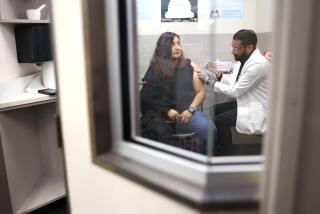Flu Shots Will Be Delayed for Some
- Share via
WASHINGTON — Troubles with distribution again will delay flu shots for Americans this month, but those needing the vaccines the most should be able to get them, according to federal health officials.
Healthy people have been advised to wait a couple of months before getting their shots to allow the elderly, chronically ill and health care workers to get the vaccine first.
“Healthy people should wait until December to get vaccinated so that the people who are at high risk for complications get their vaccine in October and November,” said Nancy Cox, chief of the influenza branch at the Centers for Disease Control and Prevention in Atlanta.
Influenza is a contagious viral infection that causes exhaustion, chills, sore throat, cough, aches and, unlike the common cold, fever.
The staggered availability is a result of fewer companies’ manufacturing the vaccine, Cox said. Last year, one of the four manufacturers halted production midstream, leaving the remaining companies to pick up the slack.
Those in the first wave include people 64 and over; those with a chronic illness such as diabetes, heart, lung, liver or kidney diseases; those with asthma or anemia; and those who are immuno-suppressed, on chemotherapy or steroids, the CDC recommends. Children older than 6 months with a chronic condition, health care workers and some pregnant women also should get a shot.
Each year a new vaccine is created after pinpointing the latest influenza viruses circulating throughout the world.
The World Health Organization, along with the CDC and other groups, each year monitors cases of influenza and collaborates on the most prevalent strains. This year’s most common viruses are A (H1N1) and A (H3N2), and a B strain.
“The experts get together and look at their cloudy crystal ball and anticipate which strains are going to be circulating,” said Dr. William Schaffner, an infectious diseases specialist at Vanderbilt University’s School of Medicine. “Then they give that information to the vaccine manufacturers, who each year have to create, in effect, a new vaccine.”
Identifying the latest flu viruses starts about 10 months before the U.S. flu season, said Linda Lambert, influenza program officer at the National Institute of Allergy and Infectious Disease. The shot is annually revised to closely mimic the latest strains circulating.
“It’s a very time-sensitive process from the word go,” she said.
Flu outbreaks are expected as early as November and will last until April, health experts said. Vaccinating is most effective at preventing young and healthy people from contracting the flu, but is key for more fragile groups.
“There’s a hierarchy of protection. Influenza vaccine is very effective at preventing the more serious complications of influenza, including hospitalization and death,” the CDC’s Cox said about protection for the sick and elderly.
Experts said most of the 79 million doses of vaccine would be available by year’s end to protect the 10% to 20% of the population that annually becomes infected. More than 100,000 people are hospitalized and at least 20,000 people die as a result of contracting the flu each year, the CDC said.






